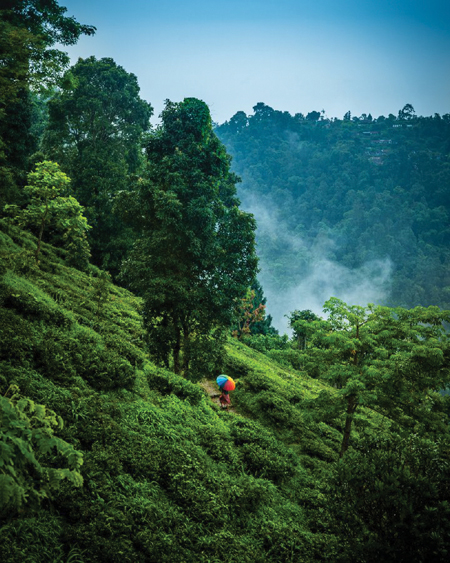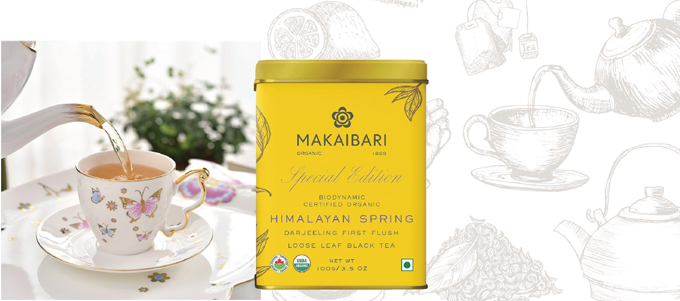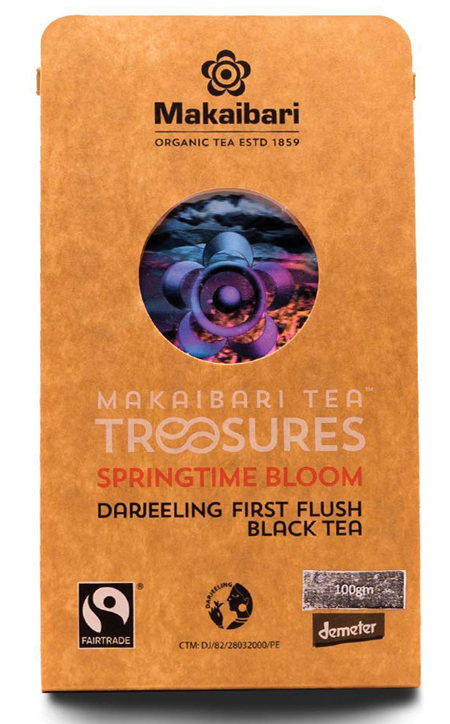Chronicles: Chai in Chittaranjan Park

The homesickness Ma and Baba felt when they left Kolkata for Orissa and then to Delhi manifested itself in many things, but mostly in tea. Apparently, North Indians didn’t know how to make or select tea. Only Bengalis did, or so they claimed.
 Every summer we received three large tin boxes in the intermittent and irregular Indian mail. Wrapped in burlap with distinct railway letters, multiple stamps haphazardly glued on, and jute string sewed through to seal the metal boxes in the gunny bag. For good measure, each side of the box was lac-sealed and shipped from North Bengal. Sometimes we’d get two tins, sometimes just one. Every time we received all three was a joyous day in the Ghosh household. Makaibari, a publicly traded company and the only one that Baba had shares and/or bonds of, was a tea estate. It was Baba’s seal of approval—to invest in a company that brought him joy.
Every summer we received three large tin boxes in the intermittent and irregular Indian mail. Wrapped in burlap with distinct railway letters, multiple stamps haphazardly glued on, and jute string sewed through to seal the metal boxes in the gunny bag. For good measure, each side of the box was lac-sealed and shipped from North Bengal. Sometimes we’d get two tins, sometimes just one. Every time we received all three was a joyous day in the Ghosh household. Makaibari, a publicly traded company and the only one that Baba had shares and/or bonds of, was a tea estate. It was Baba’s seal of approval—to invest in a company that brought him joy.
[Right] Makaibari Tea Estate
What I do know now is that it was the only Bengali-owned tea estate. The British who had everything to do with tea in India didn’t have any links with this estate, surprisingly. This in itself was a feat, given that most Darjeeling tea estates produce tea for the West, and British tea companies in particular. Recently I checked to see the ticker symbol for Makaibari, but I couldn’t find it. Was it then not a publicly traded company, a story I had heard all through my childhood? Regardless, from the ’70s to well into the ’90s, Baba and Ma eagerly awaited the first flush, or the small bud with the first leaf from the tea plant, to arrive on an abysmally slow-moving goods train to our Bengali neighborhood in New Delhi.
Makaibari, which literally translates to “place of cornfields,” is a fourth-generation-owned Bengali tea estate. Their plantation workers, called partners, are allowed to host tourists in their homes in their version of a bed-and-breakfast in the Himalayas. If one can pay one’s workers well, they wouldn’t need to share their homes with tourists to supplement their income, would they? Another way to look at this would be that the tea estate empowers women to find other entrepreneurial means of income.
They also have USDA-approved organic teas that can now be purchased globally online. It is, indeed, a modern estate with modern ways of doing business, a uniquely Indian gift to others.
“Oder chaa ta is the very best,” Baba always proclaimed when the boxes came, and then proceeded to repeat the Makaibari story of the shares and bonds he bought, as had his mother, a story that had no value or meaning for his daughters.

Those days, we had bone china cups for daily use. We kept a separate cup and saucer (thicker and therefore cheaper) for the maid who came to clean the house every day. No matter how egalitarian and progressive the family, there was and continues to be a distinct difference between upper middle-class families and their help. Feudalism continues to exist in India in subtle and interesting ways. The invisible class, or the help, enable a robust contemporary Indian economy, enable the gentrified to have a level of unprecedented luxury, and yet—as their name suggests—are unseen. That, however, is a separate discussion.
 What we had in Delhi’s Chittaranjan Park, the neighborhood formerly known as East Pakistan Displaced Persons’ (EPDP) Colony, were bone china sets for everyday use. For guests, we had a separate set of even finer bone china with gold painted rims, and wispy blue flower patterns at the lip and on the bottom of each small curvy cup. Ma would steep two or three teaspoons of that expensive tea in hot water, pouring the pale golden-brown liquid into the white cups, adding a dash of full-fat milk with a teaspoon of sugar crystals. It was a daily ritual.
What we had in Delhi’s Chittaranjan Park, the neighborhood formerly known as East Pakistan Displaced Persons’ (EPDP) Colony, were bone china sets for everyday use. For guests, we had a separate set of even finer bone china with gold painted rims, and wispy blue flower patterns at the lip and on the bottom of each small curvy cup. Ma would steep two or three teaspoons of that expensive tea in hot water, pouring the pale golden-brown liquid into the white cups, adding a dash of full-fat milk with a teaspoon of sugar crystals. It was a daily ritual.
As Bengalis, we were used to everything sweetened—a teaspoon or two of sugar in a tiny cup was an everyday occurrence. We had tea almost five or six times a day. Wash cups, rinse in hot water, add tea, milk, sugar. Dip a Nice biscuit with sugar crystals on top in it, sip the tea slowly. Clean the cups again in hot water and Vim cleaning powder before letting it dry. Repeat.
These days I only drink coffee. The best medium roast blends, but coffee nonetheless. I haven’t added sugar to my coffee in decades—I feel it only dilutes the flavor. I still add a splash of milk because the casein protein in milk reduces the caffeine acidity, making the coffee a packed-with-flavor wake-me-up.
My childhood was my Baba calling out to Ma, “Shono, aar ek cup chaa banaabe?” Listen, could you make me another cup of tea?
I never heard Ma say no. Those three tins lasted an entire year—and like clockwork, three more showed up the next summer. Chaa and the act of making chaa was an act of love, an act of family.
Madhushree Ghosh, who works in oncology diagnostics, is the author of Khabaar: An Immigrant Journey of Food, Memory, and Family, which won an Independent Publisher Book Award (Gold).
Enjoyed reading Khabar magazine? Subscribe to Khabar and get a full digital copy of this Indian-American community magazine.
blog comments powered by Disqus










